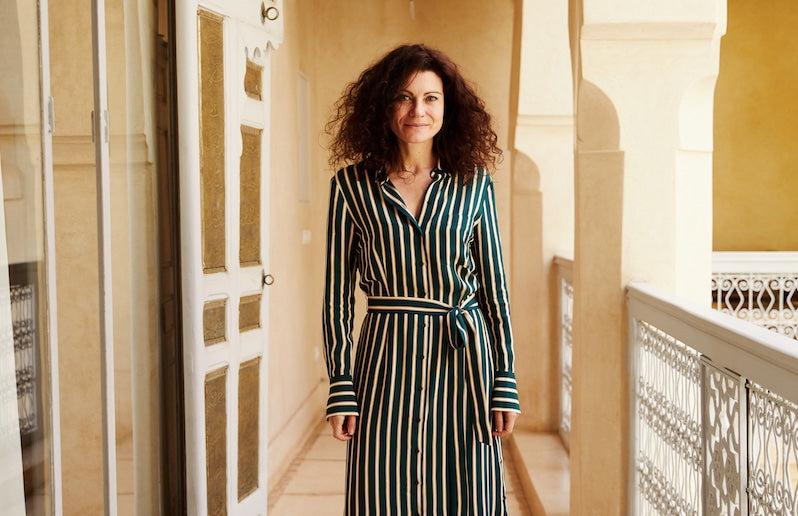Reisende, Schriftsteller, Dichter und Musiker aus aller Welt haben von ihren leidenschaftlichen Geschichten mit Marokko erzählt. Dieses Land besitzt eine einzigartige Fähigkeit, jeden in seinen Bann zu ziehen, unabhängig von Herkunft oder Lebensweg. Die ungreifbare Faszination Marokkos hinterlässt eine tief verwurzelte Sehnsucht, das Erlebte erneut zu erfahren. Die Verzauberung reicht weit über die Liebe zu kulinarischen Köstlichkeiten, leuchtenden Farben und den warmen Lächeln der Einheimischen hinaus. Der wahre Reichtum Marokkos liegt im Unausgesprochenen, das viel kraftvoller ist als das Sichtbare.
Die visuelle Pracht Marokkos ist das Ergebnis einer Vielzahl von Eindrücken, die Menschen aus nah und fern hinterlassen haben. Das Entschlüsseln der Geschichte dieser Einflüsse eröffnet neue Perspektiven auf das Marokko, das heute bekannt ist und dessen unwiderstehlicher Charme alle verzaubert – eine Reise durch das faszinierende marokkanische Kunsthandwerk.
Marokkos geografische Lage hat es unzähligen äußeren Einflüssen ausgesetzt. Als Land, das sowohl das Mittelmeer als auch den Atlantik überblickt, kulturell und physisch afrikanisch ist und Teil der historischen Seidenstraße war, ist es nicht verwunderlich, dass unterschiedliche Kulturen ihre Spuren an diesem Schnittpunkt hinterlassen haben. Die Untersuchung, wie diese Einflüsse neu interpretiert und in das marokkanische Kunsthandwerk integriert wurden, bietet einen aufregenden Einblick in die kreative Seele des Landes.
 © Photo by Max Braun via Unsplash
© Photo by Max Braun via UnsplashDie marokkanische Kultur am Beispiel von Walili (Volubilis)
Um das Zusammenspiel verschiedener kultureller Einflüsse zu verdeutlichen, dient die archäologische Stätte Walili, in der Nähe von Meknes, als anschauliches Beispiel. Walili, latinisiert als Volubilis, wird oft als römische Ruine bezeichnet. Zwar lassen sich dort typische Merkmale römischer Architektur finden, wie das charakteristische Steinmauerwerk, doch fehlen zentrale Elemente, die in selbst den kleinsten römischen Städten üblich waren, wie Kolosseum, Theater oder Zirkus. Dies deutet darauf hin, dass Walili eher eine Amazigh-Stadt war, die römischen Einfluss erfuhr.
Auch die Mosaike in Walili zeigen Spuren berberischer Volkskunst. So umgeben Linien und Kreuze die Ränder einer Mosaikplatte – Motive, die häufig in Berberteppichen aus dem Mittleren Atlas zu finden sind. Die turmförmige Linie steht in der berberischen Symbolik für das „Männliche“. In der Berberwebkunst rahmen männliche Motive wie diese oft den Teppich ein, während weibliche Symbole, etwa Rauten, innerhalb dieses Rahmens liegen und auf das Thema Fruchtbarkeit verweisen. Volubilis zeigt somit nicht nur römischen Einfluss, sondern auch, wie sich die Überschneidung von römischer und berberischer Kultur im Kunsthandwerk widerspiegelt.
 © Photo by Raul Cacho via Unsplash
© Photo by Raul Cacho via UnsplashMarokkanisches Kunsthandwerk: Die Ursprünge der marokkanischen Stickerei
Der Kaftan und die marokkanische Stickerei haben sich zweifellos zu internationalen Modeikonen entwickelt, aber wie viel wissen wir wirklich über ihre Wurzeln? So wie die marokkanische Stickerei geografische Grenzen überschreitet und die Laufstege der Modewelt erobert, ist auch der Kaftan ein Produkt der ständigen Migration von Menschen. Seine Geschichte ist eng verbunden mit den Handwerkern unterschiedlicher Religionen, die 1492 nach dem Fall des westgotischen Spaniens fliehen mussten. Diese Handwerker brachten ihre Kunstfertigkeit und Traditionen mit, die sich in der marokkanischen Stickerei widerspiegeln und bis heute fortleben.
Wenn wir das marokkanische Kunsthandwerk genauer betrachten, wird deutlicher, was Marokko so besonders macht und warum sich hier jeder heimisch fühlen kann. Das heutige Marokko ist eine einzigartige Mischung verschiedener kultureller Einflüsse, die im Laufe der Jahrhunderte auf das Land eingewirkt haben. In einer Zeit, in der immer mehr maschinell hergestellt wird, bleibt das Kunsthandwerk eine tragende Säule des marokkanischen Lebens. Es schafft Verbindungen zwischen Menschen und Kulturen, indem es uns mit unserer Vergangenheit verbindet.
Berberteppiche: Meisterwerke der Tradition
Die marokkanischen Teppiche sind bekannt für ihre lebendigen Farben und vielfältigen Texturen. Sie sind oft ein Highlight in den traditionellen Riad-Häusern und können als kunstvolle Akzente in modernen Interieurs verwendet werden. Die Teppichknüpfkunst in Marokko hat sich im Laufe der Jahrhunderte weiterentwickelt und ist von verschiedenen Kulturen beeinflusst worden.
Die Herstellung eines Berberteppichs ist ein zeitintensiver Prozess, der traditionelle Techniken erfordert, die von Generation zu Generation weitergegeben werden. Diese marokkanischen Teppiche sind oft aus Wolle oder Ziegenhaaren gefertigt und zeichnen sich durch ihre Haltbarkeit und Widerstandsfähigkeit aus. Die Verwendung von natürlichen Farbstoffen verleiht ihnen nicht nur eine einzigartige Ästhetik, sondern macht sie auch umweltfreundlich.
 © Left: Embroidery from Hungary; Right: Embroidery from Rabat, Morocco, via Moroccan Heritage Museum
© Left: Embroidery from Hungary; Right: Embroidery from Rabat, Morocco, via Moroccan Heritage Museum
Orientalisches Geschirr: Funktion trifft auf Kunst
Das orientalische Geschirr, das in den marokkanischen Haushalten zu finden ist, ist ein weiteres Beispiel für die exquisite Handwerkskunst des Landes. Die Verwendung von keramischen Materialien, die in der Region reichlich vorhanden sind, zeigt die Verbindung zwischen Natur und Kunsthandwerk. Die kunstvollen Muster und leuchtenden Farben spiegeln die Handwerkskunst wider, die in jedem Stück steckt.
Besonders die marokkanischen Teller sind für ihre dekorativen Elemente bekannt und zeigen oft filigrane Designs, die von der Natur und der Umgebung inspiriert sind. Marokkanisches Geschirr geht über die Funktionalität hinaus und sind Ausdruck des ästhetischen Geschmacks und der kulturellen Identität des Landes.
Marokkanische Taschen: Stil und Handwerkskunst vereint
Die marokkanischen Taschen sind eine weitere faszinierende Facette des reichen Kunsthandwerks des Landes. Oft aus Leder oder Textilien gefertigt, sind sie nicht nur praktische Begleiter im Alltag, sondern auch stilvolle Accessoires, die die marokkanische Ästhetik verkörpern. Die Muster und Designs variieren, beeinflusst von den kulturellen Eigenheiten der Berber- und arabischen Gemeinschaften. Durch den Kauf marokkanischer Taschen unterstützen Verbraucher die lokale Wirtschaft und tragen zur Erhaltung traditioneller Techniken bei.
Tierische Symbole im marokkanischen Kunsthandwerk: Geschichten und Bedeutungen
Die Symbole im marokkanischen Kunsthandwerk erzählen die Geschichte des traditionellen Glaubens und der kulturellen Identität des Landes. Viele dieser Symbole haben die Form von Tieren und sind in Alltagsgegenständen zu finden, wie bestickten Kaftanen, Teppichen, Schmuck und Keramik. Zu den häufigsten Tiermotiven gehören der Vogel, die Schlange, die Eidechse und das Kamel, die jeweils eine besondere Bedeutung in der marokkanischen Symbolik haben.
Das Symbol des Vogels
Vögel gelten im marokkanischen Volksglauben als glückbringend und tragen eine starke „baraka“ (Segen), mit Ausnahme von Raben und Nachtvögeln, die aufgrund ihres Verhaltens, ihrer Farbe oder ihres Rufes als unheilvoll betrachtet werden. Vögel spielen eine zentrale Rolle im Aberglauben und in der Volksmagie. In Marrakesch und anderen Mellahs (jüdischen Vierteln) glaubten einige Juden, dass Vögel Flüche gegen Häuser ausstoßen könnten. Andere Vogelarten wie Adler, Raubvögel, Schwalben, Sperlinge und Turteltauben hingegen werden als heilig betrachtet.
Da Vögel im Himmel leben, gelten sie als Vermittler zwischen Himmel und Erde. Es wird gesagt, dass Wahrsager zahme Vögel nutzen, um Botschaften zu empfangen, die sie vierzig Tage vor ihrem Eintreffen verkünden lassen. Auf gestickten Stücken aus Rabat flattern Vögel aller Art zwischen Blumen und verleihen den Textilien eine besondere Bedeutung.

© Photo via ABURY
Das Symbol der Schlange
Die Schlange wird in der marokkanischen Symbolik als König des Landes verehrt, der die Geheimnisse der von ihm durchstreiften Gebiete kennt. Sie steht für Wissen und Schutz und erscheint oft auf Talismanen. Bekannt als „Hüter der Schätze“, verkörpert sie Weisheit und magische Kräfte, die vor Gefahren bewahren sollen.
Das Symbol der Eidechse
Die Eidechse ist in der Volkskultur für ihre Jagd nach der Sonne bekannt, was ihr den Ruf einer kontemplativen, nachdenklichen Seele verleiht. Dank ihrer Fähigkeit, ihren Schwanz zu regenerieren, wird sie außerdem mit Unsterblichkeit in Verbindung gebracht.
Das Symbol des Kamels
Früher spielten Kamele eine bedeutende Rolle, insbesondere bei den Moussems, den traditionellen Festen des Landes. Sie wurden in den Vierteln von Marrakesch stolz präsentiert und anschließend im Dorf Moulay Brahim geopfert, um symbolisch die Sünden der Gemeinschaft auf sich zu nehmen.
Jenseits der oberflächlichen Schönheit Marokkos
Wenn wir über ein so vielfältiges und reiches Land wie Marokko sprechen, ist es wichtig, über die Oberfläche hinauszugehen. Die Farben und Aromen Marokkos begeistern, aber das Kunsthandwerk des Landes entfaltet seine wahre Faszination erst bei einer Erforschung seiner tiefen kulturellen Bedeutung. Hinter der offensichtlichen Schönheit steckt eine Geschichte, die Marokko so inspirierend, demütigend und voller Wunder macht. Der wahre Charme des Landes liegt unter der sichtbaren Oberfläche, und genau das erobert die Herzen von Reisenden und Einheimischen gleichermaßen.






Share: